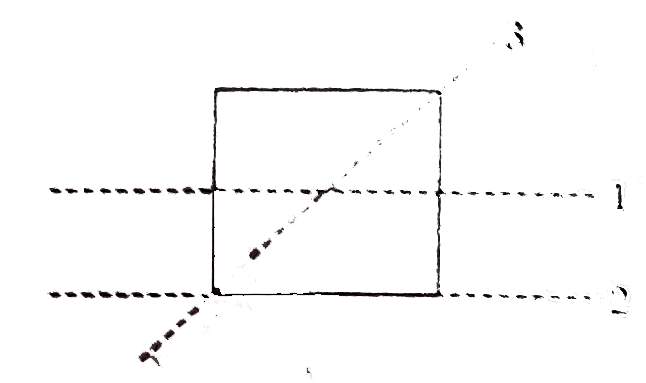Match the following
Table-1Table-2(A)L(P)[M0L0T−2](B)Magnetic Flux(Q)[ML2T−2A−1](C)LC(R)[ML2T−2A−2](D)CR2(S)None
The correct Answer is:(A) R, (B) Q, (C) S, (D) R
Step by step video & image solution for Match the following {:(,,"Table-1",,"Table-2"),(,(A),L,(P),[M^(0)L^(0)T^(-2)]),(,(B),"Magnetic Flux",(Q),[ML^(2)T^(-2)A^(-1)]),(,(C),LC,(R),[ML^(2)T^(-2)A^(-2)]),(,(D),CR^(2),(S),"None"):} by Physics experts to help you in doubts & scoring excellent marks in Class 12 exams.
Similar Questions
Match the following.
∣∣ ∣ ∣ ∣ ∣ ∣ ∣ ∣∣Table-1Table-2(A)Coefficient of viscosity(P)[M2L−1T−2](B)Surface tension(Q)[ML0T−2](C)Modulus of elasticity(R)[ML−1T−2](D)Energy per unit volume(S)Noneof a fiuid∣∣ ∣ ∣ ∣ ∣ ∣ ∣ ∣∣View SolutionMatch the following columns.
Column IColumn IIA.Teslap[ML2A−2T−2]B.Weberq[MLA−2T−1]C.Weber m−2r.[MA−1T−2]D.Henrys.NoneView SolutionFour rods of equal length l and mass m each forms a square as shown in figure
Moment of inertia about three axes 1,2 and 3 are say I1,I2andI3. Then, match the following columns

Column-IColumn-II(A)I1(p)43ml2(B)I2(q)23ml2(C)I3(r)12ml2(s)NoneView SolutionColumn IColumn II(A)GMeMs(p)[M2L2T−3](B)3RTM(q)[ML3T−2](C)F2q2B2(r)[L2T−2](D)GMeRe(s)None
View SolutionMatch the following
Table - 1Table - 2(A)σ2/ε0(P)C2/J−m(B)ε0(Q)Farad(C)ampere - secondVolt(R)J/m3(D)VE(S)metreView SolutionColumn IColumn II(A)Electrical resistance(p)[M−1L−2T4A2](B)Capacitance(q)[ML2T−2A−2](C)Magnetic field(r)[ML2T−3A−2](D)Inductance(s)[MT−2A−1]
View SolutionComparing L-C oscillation with the oscillation if spring-block-system, match the following table.
Comparing L-C oscillations with the oscillations of spring-block sytem, match the following table Table-1(LC oscillations)Table-2(Spring-block oscillations)(A)L(P)k(B)C(Q)m(C)i(R)v(D)didt(S)x(T)NoneView SolutionMatch the following :
Column-IColumn-II(A)3s1(p)n=3(B)3p1(q)l=0(C)4s1(r)l=1(D)4d1(s)m=0(t)m=±1View SolutionA.Spring constant1.[M1L2T−2]B.Pascal2.[M0L0T−1]CHertz3.[M1L0T−2]D.Joule4.[M1L−1T−2]
View SolutionMatch the following two columns.
Column IColumn IIA.Electrical resistance1.[ML3T−3A−2]B.Electrical potential2.[ML2T−3A−2]C.Specific resistance3.[ML2T−3A−1]D.Specific conductance4.NoneView Solution

